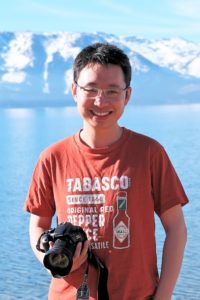 Li Li is an Assistant Professor leading the Health & Environment Assessment Team (HEAT) at the University of Nevada, Reno since 2019. He obtained his BSc and PhD degrees from Nankai University in 2012 and Peking University in 2017, respectively, and received postdoctoral training at the University of Toronto Scarborough between 2017 and 2019. His research seeks to understand the accumulation, transport, transformation of synthetic chemicals (e.g., flame retardants, plasticizers, pesticides, and surfactants) and materials (e.g., nanomaterials and microplastics) in a nexus comprising the human socioeconomic system, environment, and food webs, as well as the resulting adverse environmental and health effects. He strives to establish, foster, maintain, and promote a variety of mechanistically sound and computationally effective models, to advance our thinking and understanding of the behavior and processes of synthetic chemicals and materials and meanwhile to inform decision making.
Li Li is an Assistant Professor leading the Health & Environment Assessment Team (HEAT) at the University of Nevada, Reno since 2019. He obtained his BSc and PhD degrees from Nankai University in 2012 and Peking University in 2017, respectively, and received postdoctoral training at the University of Toronto Scarborough between 2017 and 2019. His research seeks to understand the accumulation, transport, transformation of synthetic chemicals (e.g., flame retardants, plasticizers, pesticides, and surfactants) and materials (e.g., nanomaterials and microplastics) in a nexus comprising the human socioeconomic system, environment, and food webs, as well as the resulting adverse environmental and health effects. He strives to establish, foster, maintain, and promote a variety of mechanistically sound and computationally effective models, to advance our thinking and understanding of the behavior and processes of synthetic chemicals and materials and meanwhile to inform decision making.
Read Li Li’s Emerging Investigator Series article “the role of chemical properties in human exposure to environmental chemicals” and read more about her in the interview below:
Your recent Emerging Investigator Series paper reviewing the role of chemical properties in human exposure to environmental chemicals. How has your research evolved from your first article to this most recent article?
I research various chemical substances manufactured and commercialized by humans and but found to be hazardous to humans and other organisms. For the past years, I have been striving to develop a holistic, mechanistic modeling framework to describe the complete continuum from the production of these chemical substances to their occurrence within the human body. This modeling framework integrates various components such as production, environmental releases, environmental concentrations, exposure, and risks. It allows exploring how human exposure to chemical substances responds to industrial and consumption activities, physicochemical properties of chemicals, features of the environment of interest, and human behavior. I first managed to bridge chemical production, environmental releases throughout the lifecycle, and multimedia environmental concentrations through my doctoral work (compiled as a book entitled “Modeling the Fate of Chemicals in Products” published by Springer). This work was then expanded, during my post-doctoral training, to include the exposure of humans and various ecological receptors, leading to the birth of a comprehensive exposure model named “PROduction-To-EXposure (PROTEX)”. During the most recent year, I continued to extend the chain of models to include toxicity and health outcomes to support assessments of health risks and impacts. This ambitious modeling framework now enables scientists, industrial users, and policymakers to predict what would happen to our environment and health if we decide to manufacture a certain amount of a certain chemical substance; it also allows linking the adverse environmental and health impacts at the current moment back to the regrettable decisions decades ago.
What aspect of your work are you most excited about at the moment?
The interdisciplinarity of my work is the most fascinating. The quantitative characterization of the continuum from chemical production to environmental and health impacts, requires synergistic leveraging of the knowledge and successful experience in environmental chemistry, exposure and health sciences, and industrial ecology. We need systematic understandings of how chemicals move, change, and accumulate in the human socioeconomic system, the physical environment, and the bodies of humans and other organisms. An example is this Emerging Investigators article, which discusses how properties of partitioning, dissociation, reaction, and mass transfer (concepts in environmental chemistry) govern and impact external and internal exposure to various chemical substances (concepts in exposure science). Both environmental chemists and exposure scientists can benefit from reading this paper. I am proud that I am one of the pioneers seeking to fuse these independent research areas and make them interdependent and interconnected.
In your opinion, what are the most important questions to be asked/answered in this field of research?
I think the most important question is to understand how human activities (manufacturing and consumption of chemical substances, behaviors related to chemical intake, measures for mitigating health risks or impacts, etc.) and chemical properties (tonnage, partitioning, reaction, dissociation, mass transfer, etc.) interactively determine human exposure to chemicals and associated health outcomes. Especially, we need a better understanding and characterization of how variabilities in these two aspects (e.g., interindividual variabilities in toxicokinetics, behavior, and toxicological susceptibility, as well as inter-chemical variabilities in partition ratios, half-lives, and mass transfer coefficients) shape the varied human exposure and health outcomes.
Such a systematic understanding is of vital importance because we are exposed to a myriad of chemical substances present in the multimedia environment, released from multiple lifecycle sources, through multiple exposure routes – it is close to impossible to investigate every single chemical case by case. And we also need to identify the most vulnerable and susceptible subgroups of people with disproportionate chemical exposure if we want to protect every single person in our community for environmental justice and fairness.
What do you find most challenging about your research?
The interdisciplinarity also brings about challenges. There has long been a lack of communication and dialog between scientists from these different disciplines. Knowledge and experience are largely compartmentalized and fragmented. For instance, while environmental releases “remain the least understood part of the research” to environmental chemists, industrial ecologists already have a wide range of well-established, mature methodologies on hand for estimating the lifecycle releases of chemical substances. However, since data of environmental releases are not directly measurable or observable, they cannot be evaluated or validated without being converted to concentrations in environmental compartments, which often plagues industrial ecologists due to the lack of fate and transport modeling techniques in industrial ecology. In addition, a common language or knowledge is also missing in many cases. An example is the biotransformation of chemical substances inside the organism body: while its important role in determining bioaccumulation and human dietary ingestion of chemical substances has been very well recognized and characterized by environmental chemists, as reviewed in this Emerging Investigators article, it has yet to be widely accepted by most exposure scientists and/or toxicologists. Also, terminologies and nomenclatures vary among these different disciplines, which adds difficulties to communication and dialog between these research areas. For example, just ask ourselves: what are we talking about when saying “bioavailability”? When using this word, are we really referring to the same thing as an environmental chemist, a toxicologist, an exposure scientist, or a pharmaceutical scientist does?
In which upcoming conferences or events may our readers meet you?
I usually attend the annual meetings of the Society of Environmental Toxicology and Chemistry in North America and Europe. I am also a frequent attendee of the annual meetings of the International Society of Exposure Science.
How do you spend your spare time?
I spend my spare time with my wife, hanging out, watching films and variety shows, and exploring various food and fun. I am also a nice photographer!
Which profession would you choose if you were not a scientist?
I may choose to become a journalist, as I love to investigate the truths beneath the surface and share intriguing stories with others. To me, a scientist is quite similar to a journalist, as they both relay something unknown to the audience through their efforts of exploration.
Can you share one piece of career-related advice or wisdom with other early-career scientists?
It is important to understand both the big picture of the research area and the detailed, fundamental technical skills (e.g., laboratory, modeling, fieldwork, observational methodologies) required in the research area. Vision is crucial to success, but bringing vision into reality is more important. After all, “talk is cheap, show me the data”.













